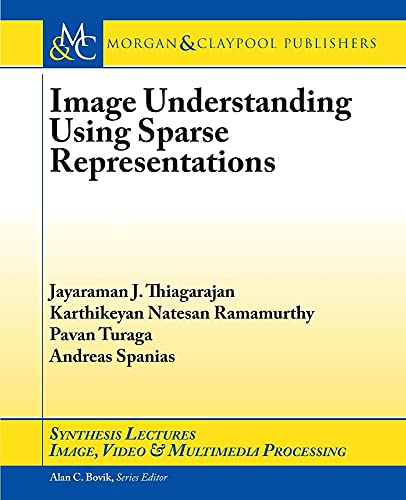Artículos relacionados a Image Understanding using Sparse Representations (Synthesis...
Image Understanding using Sparse Representations (Synthesis Lectures on Image, Video, and Multimedia Processing) - Tapa blanda

Páginas:120Géneros:12:TTBM:Imagingsystems&technologySinopsis:Imageunderstandinghasbeenplayinganincreasinglycrucialroleinseveralinverseproblemsandcomputervision.Sparsemodelsformanimportantcomponentinimageunderstanding,sincetheyemulatetheactivityofneuralreceptorsintheprimaryvisualcortexofthehumanbrain.Sparsemethodshavebeenutilizedinseverallearningproblemsbecauseoftheirabilitytoprovideparsimonious,interpretable,andefficientmodels.Exploitingthesparsityofnaturalsignalshasledtoadvancesinseveralapplicationareasincludingimagecompression,denoising,inpainting,compressedsensing,blindsourceseparation,super-resolution,andclassification.Theprimarygoalofthisbookistopresentthetheoryandalgorithmicconsiderationsinusingsparsemodelsforimageunderstandingandcomputervisionapplications.Tothisend,algorithmsforobtainingsparserepresentationsandtheirperformanceguaranteesarediscussedintheinitialchapters.Furthermore,approachesfordesigningovercomplete,data-adapteddictionariestomodelnaturalimagesaredescribed.Thedevelopmentoftheorybehinddictionarylearninginvolvesexploringitsconnectiontounsupervisedclusteringandanalyzingitsgeneralizationcharacteristicsusingprinciplesfromstatisticallearningtheory.Anexcitingapplicationareathathasbenefitedextensivelyfromthetheoryofsparserepresentationsiscompressedsensingofimageandvideodata.Theoryandalgorithmspertinenttomeasurementdesign,recovery,andmodel-basedcompressedsensingarepresented.Theparadigmofsparsemodels,whensuitablyintegratedwithpowerfulmachinelearningframeworks,canleadtoadvancesincomputervisionapplicationssuchasobjectrecognition,clustering,segmentation,andactivityrecognition.Frameworksthatenhancetheperformanceofsparsemodelsinsuchapplicationsbyimposingconstraintsbasedonthepriordiscriminatoryinform
"Sinopsis" puede pertenecer a otra edición de este libro.
Reseña del editor:
Image understanding has been playing an increasingly crucial role in several inverse problems and computer vision. Sparse models form an important component in image understanding, since they emulate the activity of neural receptors in the primary visual cortex of the human brain. Sparse methods have been utilized in several learning problems because of their ability to provide parsimonious, interpretable, and efficient models. Exploiting the sparsity of natural signals has led to advances in several application areas including image compression, denoising, inpainting, compressed sensing, blind source separation, super-resolution, and classification. The primary goal of this book is to present the theory and algorithmic considerations in using sparse models for image understanding and computer vision applications. To this end, algorithms for obtaining sparse representations and their performance guarantees are discussed in the initial chapters. Furthermore, approaches for designing overcomplete, data-adapted dictionaries to model natural images are described. The development of theory behind dictionary learning involves exploring its connection to unsupervised clustering and analyzing its generalization characteristics using principles from statistical learning theory. An exciting application area that has benefited extensively from the theory of sparse representations is compressed sensing of image and video data. Theory and algorithms pertinent to measurement design, recovery, and model-based compressed sensing are presented. The paradigm of sparse models, when suitably integrated with powerful machine learning frameworks, can lead to advances in computer vision applications such as object recognition, clustering, segmentation, and activity recognition. Frameworks that enhance the performance of sparse models in such applications by imposing constraints based on the prior discriminatory information and the underlying geometrical structure, and kernelizing the sparse coding and dictionary learning methods are presented. In addition to presenting theoretical fundamentals in sparse learning, this book provides a platform for interested readers to explore the vastly growing application domains of sparse representations.
Biografía del autor:
Lawrence Livermore National Laboratory
"Sobre este título" puede pertenecer a otra edición de este libro.
- EditorialMorgan & Claypool Publishers
- Año de publicación2014
- ISBN 10 162705359X
- ISBN 13 9781627053594
- EncuadernaciónTapa blanda
- Número de páginas118
EUR 47,43
Gastos de envío:
EUR 3,68
A Estados Unidos de America
Los mejores resultados en AbeBooks
Image Understanding using Sparse Representations (Synthesis Lectures on Image, Video, and Multimedia Processing)
Publicado por
Morgan & Claypool Publishers
(2014)
ISBN 10: 162705359X
ISBN 13: 9781627053594
Antiguo o usado
Tapa blanda
Cantidad disponible: 2
Librería:
Valoración
Descripción Condición: VeryGood. Fast Shipping - Safe and Secure 7 days a week!. Nº de ref. del artículo: 3TWOWA001LXF
Comprar usado
EUR 47,43
Convertir moneda

